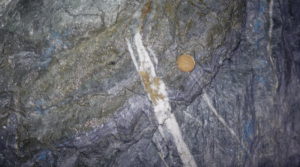In the paper he wrote together with PhD student Duncan McLeish and other colleagues, the researcher explains that most gold deposits form over millions of years, which is what it takes to fill with gold a single centimetre-wide crack on Earth’s crust once very large volumes of hot water have flowed through it. This is not the case, however, for ultrahigh-grade deposits.
Using an electron microscope to observe particles in thin slices of rock at Pretium Resources’ (TSX, NYSE: PVG) Brucejack mine in northwestern British Columbia, William-Jones and McLeish discovered that pretty much like in the process that turns milk sour, gold colloids – which consist of charged nanoparticles of gold that repel each other – are clumped together but when the charge breaks down, they flocculate to form a jelly. This jelly gets trapped in the cracks of rocks to form ultra high-grade gold veins.

“[Similarly], milk consists of little butterfat particles that are suspended in water because they repel each other, like the negative ends of two magnets. When the milk goes sour the surface charge breaks down, and the particles clump together to form a jelly,” William-Jones pointed out.
According to the scientists, this is the first evidence for gold colloid formation and flocculation in nature and the first images of small veins of gold colloid particles and their flocculated aggregates at the nano-scale.
“These images document the process by which the cracks are filled with gold and, scaled up through the integration of millions of these small veins, reveal how bonanza veins are formed,” William-Jones said. “Our results are important to the mineral exploration and mining industry in Canada and around the world.”
In the scientists’ view, now that the mystery of how bonanza deposits form has been revealed, mineral exploration companies can better explore for them and possibly for other gold deposits.
“We suspect that the colloidal processes that operated at Brucejack and other bonanza gold systems may also have operated to form more typical gold deposits,” William-Jones said. “The challenge will be to find suitable material to test this hypothesis. At Brucejack, the next step will be to better understand the reasons why colloid formation and flocculation occurred on the scale observed and reconstruct the geological environment of these processes. We have also been preparing gold colloids in the lab in an attempt to simulate what we discovered at Brucejack.”
The researcher also said that it is important to carry out genetic studies of Canada’s most fertile metallogenic districts in order to better understand how world-class mineral deposits form, and thereby develop more effective exploration strategies.




